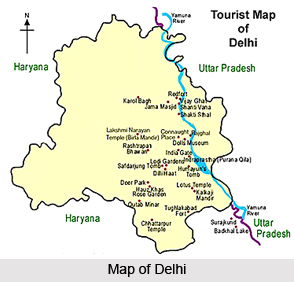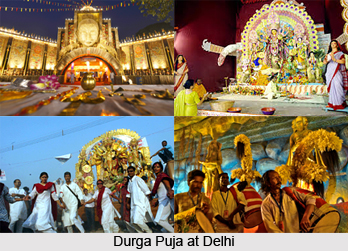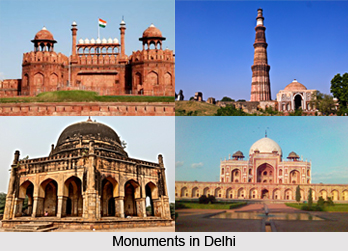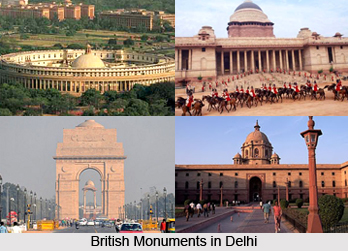 Delhi is officially referred to as the National Capital Territory of Delhi (NCT). It is the capital city of India. Delhi is the largest metropolis in terms of area and the second largest in population in India. The National capital territory of Delhi includes the region of Noida, Faridabad, Gurgaon and Ghaziabad. New Delhi is located on the banks of Yamuna River. Delhi is home to Asia`s largest planned residential colony which is called Dwaraka sub city.
Delhi is officially referred to as the National Capital Territory of Delhi (NCT). It is the capital city of India. Delhi is the largest metropolis in terms of area and the second largest in population in India. The National capital territory of Delhi includes the region of Noida, Faridabad, Gurgaon and Ghaziabad. New Delhi is located on the banks of Yamuna River. Delhi is home to Asia`s largest planned residential colony which is called Dwaraka sub city.
History of Delhi
The history of Delhi is rooted in mythology and is believed to be the site of Indraprastha which was the capital of the Pandavas in the Indian epic Mahabharata. During the 3rd century B.C, Delhi was under the Maurya Empire. The remnants of seven chief cities have been discovered in Delhi. Delhi has seen the rise and fall of many historical dynasties which have left behind a surplus of monuments that are the magnificence and glory of past ages. In the 13th century, Delhi fell into the hands of the Delhi Sultanates and subsequently it came under the dominion of the Mughal Empire. Delhi passed on to the hands of the British in 1803 AD. It was only in 1911, when the capital of British Empire was shifted from Kolkata to Delhi and that Delhi got its present prestige. After Independence of India in 1947, Delhi was conferred as the capital city but it largely remained a Chief Commissioner`s government. In 1956, Delhi was converted into a Union Territory and gradually a Lt. Governor replaced the Chief Commissioner. In 1991, the National Capital Territory Act was passed by the Parliament and a system of diarchy (a form of government having two joint rulers) was introduced under which, the elected Government was given wide powers; except law and order which remained with the Central Government. The actual enforcement of the legislation came in 1993.
In the 13th century, Delhi fell into the hands of the Delhi Sultanates and subsequently it came under the dominion of the Mughal Empire. Delhi passed on to the hands of the British in 1803 AD. It was only in 1911, when the capital of British Empire was shifted from Kolkata to Delhi and that Delhi got its present prestige. After Independence of India in 1947, Delhi was conferred as the capital city but it largely remained a Chief Commissioner`s government. In 1956, Delhi was converted into a Union Territory and gradually a Lt. Governor replaced the Chief Commissioner. In 1991, the National Capital Territory Act was passed by the Parliament and a system of diarchy (a form of government having two joint rulers) was introduced under which, the elected Government was given wide powers; except law and order which remained with the Central Government. The actual enforcement of the legislation came in 1993.
Geography of Delhi
Delhi is the largest city in India and is bordered on the east by the state of Uttar Pradesh and on the north, west, and south by Haryana. Delhi lies at an altitude of between 700 and 1,000 feet and covers an area of 1,485 square kilometers.
Climate of Delhi
 Delhi enjoys an extreme type of continental climate. The summers in Delhi are very hot and winters very cold. The temperature range varies from 45 degrees in summers to 4 degrees in winters. The winters are marked by mist and fog. The cold wave from the Himalayan mountains region makes winters very chilly. In summers, the heat wave is immense and adequate precaution has to be taken before going out in the hot summer afternoons.
Delhi enjoys an extreme type of continental climate. The summers in Delhi are very hot and winters very cold. The temperature range varies from 45 degrees in summers to 4 degrees in winters. The winters are marked by mist and fog. The cold wave from the Himalayan mountains region makes winters very chilly. In summers, the heat wave is immense and adequate precaution has to be taken before going out in the hot summer afternoons.
Demography of Delhi
According to the 2011 estimation, the total population of Delhi is 16,753,235. The population density of Delhi is 11,297 persons per square kilometer. The literacy rate of Delhi is 89.38 percent. People living in Delhi are mostly Hindus and Muslims. People here use to speak Hindi, Urdu and Punjabi.
Culture of Delhi
Culture of Delhi is diverse in nature because since ancient times it has been a seat of power to many dynasties of India. In other words, it is a kind of synthesis and reflection of the culture of India, as a whole. The religious festivals like Diwali, Holi, Mahavir Jayanti and Durga puja are celebrated with great pomp and show in Delhi. Due to Delhi`s large cosmopolitan and migrant population cuisines from all over India are available here but it excels in Punjabi and Mughal delicacies. A variety of Indian handicrafts and handlooms are noteworthy in the market places of Delhi.
Education of Delhi
The education system in Delhi is administered by the NCT governments, the Director of Education or by Private organisations. There were 2,515 primaries, 635 middle, 504 secondary and 1,208 senior secondary schools in Delhi. Delhi University and the Jawaharlal Nehru University are among the renowned universities of Delhi. The private schools of Delhi are affiliated to the administering bodies.
Administration of Delhi
 With the formation of National Capital Territory of Delhi (NCT) in July 2007, the boundaries of Delhi are expanded and included 9 districts, 27 tehsils, 59 census towns, 165 villages and three statutory towns. The Municipal Corporation of Delhi (MCD), the New Delhi Municipal Committee (NDMC); and the Delhi Cantonment Board (DCB) are the governing bodies of Delhi. The National Capital Territory (NCT) of Delhi includes the areas of Noida, Gurgaon, Greater Noida, Faridabad and Ghaziabad forming it a federally administered union territory. The Parliament of India, the Supreme Court of India and the Rashtrapati Bhavan are located in Delhi. There are seventy assembly constituencies and seven Lok Sabha constituencies in Delhi.
With the formation of National Capital Territory of Delhi (NCT) in July 2007, the boundaries of Delhi are expanded and included 9 districts, 27 tehsils, 59 census towns, 165 villages and three statutory towns. The Municipal Corporation of Delhi (MCD), the New Delhi Municipal Committee (NDMC); and the Delhi Cantonment Board (DCB) are the governing bodies of Delhi. The National Capital Territory (NCT) of Delhi includes the areas of Noida, Gurgaon, Greater Noida, Faridabad and Ghaziabad forming it a federally administered union territory. The Parliament of India, the Supreme Court of India and the Rashtrapati Bhavan are located in Delhi. There are seventy assembly constituencies and seven Lok Sabha constituencies in Delhi.
Economy of Delhi
Delhi is the largest commercial centre in the north India. The tertiary economical sector adds to 70.95 percent of Delhi`s gross SDP followed by secondary sector with 25.2 percent and primary sectors with 3.85 percent contribution. Construction, health, power, telecommunications and community services, and real estate form essential parts of Delhi`s financial system. Delhi has India`s biggest and one of the fastest growing retail industries.
Tourism in Delhi
Delhi is dotted with many places of interests like Swaminarayan Akshardham temple, Mughal gardens, Raj Ghat, Chandni Chowk, Jantar Mantar, Laxminarayan Temple, Gurudwara Bangla Sahib, Lotus Temple, Jama Masjid, Connaught Place, Red Fort, Qutb Minar, Qila Rai Pithora and many other monuments and temples, which showcase the rise and fall of many bygone dynasties.






